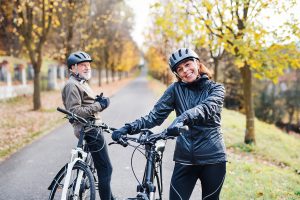 Have you noticed? Here in the northern hemisphere our days are getting shorter. I can feel the change in seasons, triggering an urge to stay indoors and curl up with a good book. But seniors beware: lack of sunshine has adverse affects.
Have you noticed? Here in the northern hemisphere our days are getting shorter. I can feel the change in seasons, triggering an urge to stay indoors and curl up with a good book. But seniors beware: lack of sunshine has adverse affects.
Exposure to sunshine allows your body to create Vitamin D, which helps you absorb calcium, one of the main building blocks of bone. With aging, comes loss of balance, and more falls. We need to keep our bones strong to prevent fractures.
Vitamin D also has a role in your nervous, muscle, and immune systems. The skin of older adults is less efficient in making vitamin D. Our kidneys are less able to convert vitamin D to its active form. As a result, seniors are more prone to vitamin D deficiency.
Vitamin D Deficiency
You can become deficient in vitamin D for different reasons:
- Insufficient vitamin D in your diet (mushrooms, fish oil, egg yolks, Salmon)
- You don’t absorb enough vitamin D from food (a malabsorption problem)
- Not enough exposure to sunlight
- Your liver or kidneys cannot convert vitamin D to its active form in the body
- Medications that interfere with your body’s ability to convert or absorb vitamin D
The amount of vitamin D you need each day depends on your age. The recommended amounts are:
- Adults 19-70 years: 600 IU
- Adults 71 years and older: 800 IU
Sunshine is a great, natural way to increase your vitamin D, especially if you’re exercising outdoors.
Cancer Fighter: Sunshine
Exposure to sunlight increases the release of the serotonin hormone in your brain. Exposure to the ultraviolet B in the sun’s rays causes a person’s skin to create vitamin D, which plays a big role in bone health. Moderate amounts of sunlight have cancer preventive benefits for colon cancer, Hodgkin’s lymphoma, ovarian cancer, pancreatic cancer, and prostate cancer.
According to experts at The Cleveland Clinic:
Sunlight has other hidden benefits. With its power to produce vitamin D, it protects against depression, insomnia and an overactive immune system, geriatrician Ronan Factora, MD, says.
“There are some links between sunlight exposure and improved muscle function, bone and cardiovascular health, improved mood—even improved cognitive function,” Dr. Factora says.
How Much is Enough?
Seniors should get anywhere from five to fifteen minutes of sunlight on your arms, hands, and face two to three days per week, according to the World Health Organization.
Note that the sun must actually penetrate the skin―wearing sunscreen or clothing won’t result in vitamin D production―so I recommend getting sun early in the day or later in the afternoon to avoid sunburn and skin cancer. Obviously, you should avoid long hours in the sun.
What About Skin Cancer?
Of course, anyone who has battled skin cancer needs to take precaution. You can wear UV protective clothing and glasses anytime, regardless of the weather. But for older adults who have been free from cancer, researchers recommend a balanced approach to sun exposure. According to Dr. Factora, you should try to get at least some exposure to sunshine several days a week.
If you want to know more about vitamin D, check out this Harvard Research. Then, let’s get outside for some sunshine!

Recent Comments